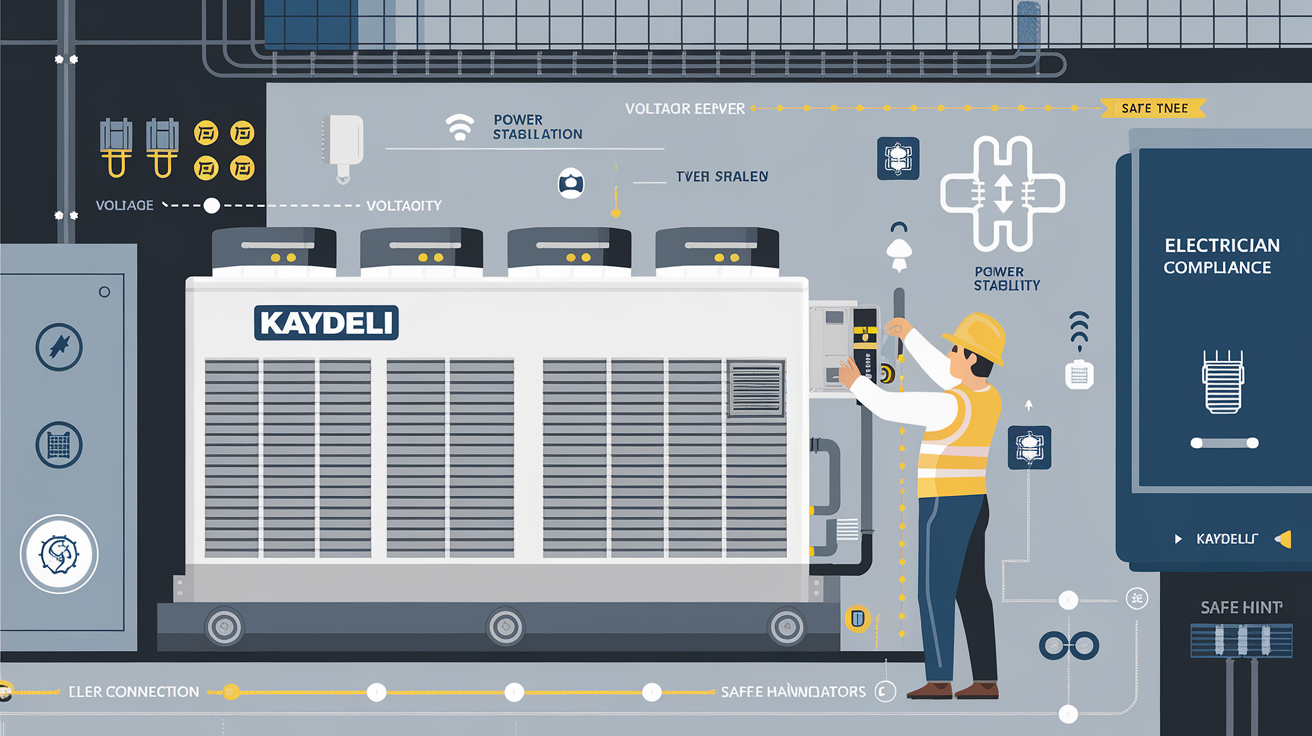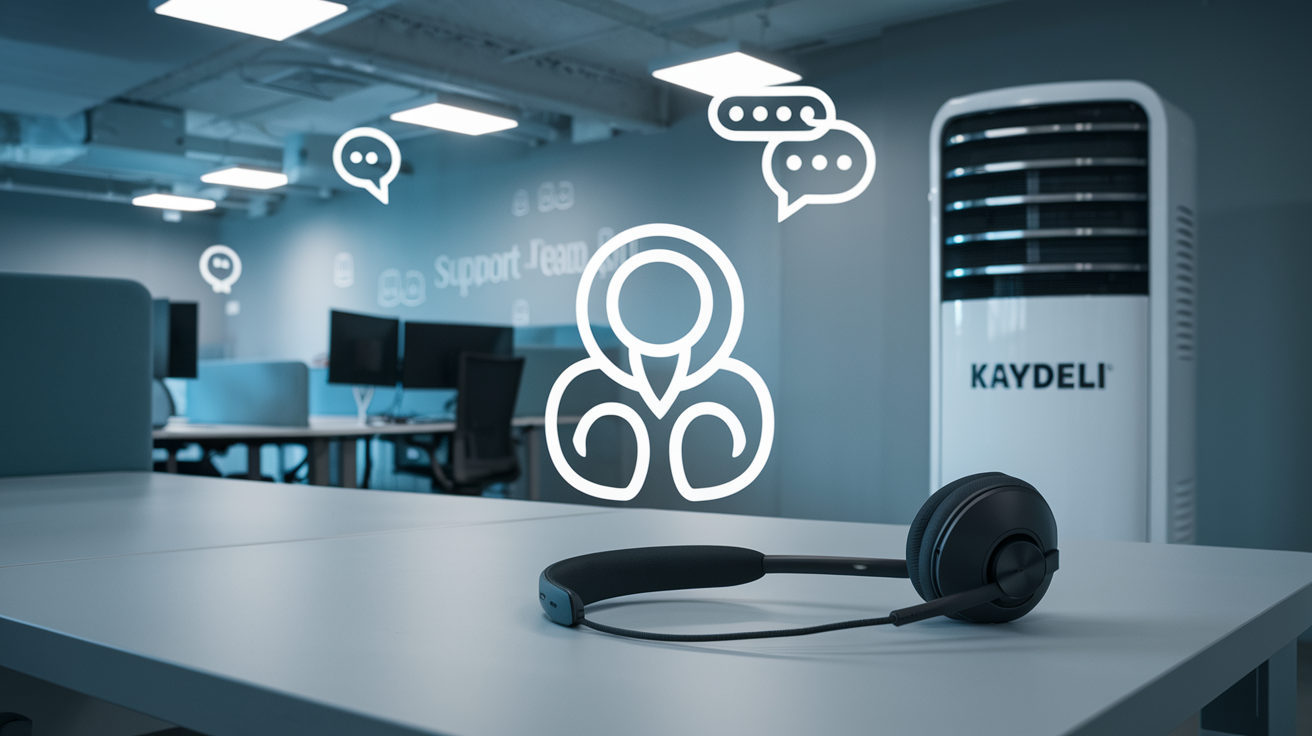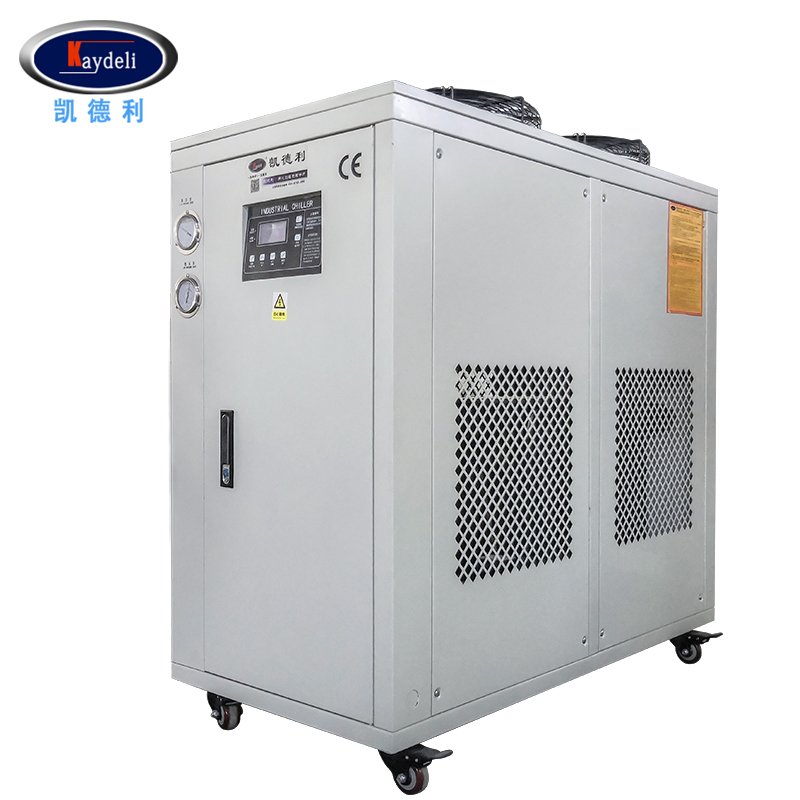- Kaydeli
- Scroll or Piston Type Chillers
Scroll or Piston Type Chillers
Catalogy:Air Cooled Chillers

Determine the right cooling capacity for your setup by estimating kilowatt requirements per hour. 🤓
|
Cooling Capacity: -- kW
|
|
Basic Working Principle of Chillers
Chillers operate on a refrigerant cycle to provide efficient cooling by extracting heat from designated areas. This cycle involves four main stages:
Compression
Condensation
Expansion
Evaporation
This process enables chillers to provide consistent cooling in various industrial and commercial applications by continuously removing heat from the environment.
What Are Scroll and Piston Type Chillers?
Scroll and piston-type chillers are two specific air-cooled chillers with distinct compressor designs, each offering unique benefits for different cooling requirements.
Scroll compressors use a spiral scroll mechanism to achieve smooth and quiet refrigerant compression, making them ideal for environments where low noise is essential. Here’s how they work:
•The compressor consists of a fixed scroll and a moving scroll that rotates within it, gradually compressing the refrigerant to high pressure.
•This design eliminates intense mechanical contact, reducing noise and vibration.
•Ideal Applications: Scroll compressors are well-suited for office buildings, hotels, and public spaces where a quiet, stable cooling system is preferred.
Piston compressors, also known as reciprocating compressors, rely on a piston-driven mechanism that creates high-pressure cooling, making them ideal for demanding cooling applications. Here’s their operation:
•The piston compressor uses pistons within cylinders, similar to an engine, to compress refrigerant with strong force.
•This design allows for high compression ratios, delivering more powerful cooling for intensive applications.
•Ideal Applications: Piston compressors are commonly used in industrial settings, laboratories, and manufacturing plants, where high cooling power is essential.
Key Differences Between Scroll and Piston Compressors
•Noise Level: Scroll compressors offer quieter operation and are suitable for noise-sensitive environments.
•Cooling Power: Piston compressors provide higher cooling capacity and pressure, making them ideal for industrial applications requiring intensive cooling.
Comparison with Other Types of Air-Cooled Chillers
Different air-cooled chillers—like Scroll, Piston, Screw, Low Temperature, Dual-Use, PCB, and Oil Cooling—offer specific cooling advantages. Scroll and Piston Chillers deliver versatile, quiet cooling for offices and factories, while other types are specialized for intense cooling needs or precision applications. The table below highlights each chiller type’s unique benefits.
| Chiller Type | Description | Best Use | Difference |
|---|---|---|---|
| Scroll and Piston Type Chillers | Efficient, versatile cooling with scroll or piston compressors. | Offices, hotels, factories. | Quiet operation with high-pressure cooling options. |
| Screw Type Chillers | Rotary screws for large-capacity, continuous cooling. | Data centers, large industrial facilities. | Higher capacity but more energy use and noise. |
| Low Temperature Chillers | Engineered for deep cooling at sub-zero temperatures. | Pharmaceuticals, chemical processing. | Designed for extreme cooling; Scroll/Piston for standard ranges. |
| Dual-Use Temperature Chillers | Switches between heating and cooling as needed. | Labs, testing facilities with variable temperature needs. | Offers both heating and cooling; Scroll/Piston are for cooling only. |
| PCB Industry Chillers | Precision cooling for printed circuit board manufacturing. | Electronics manufacturing, PCB production. | Exact temperature control, whereas Scroll/Piston are general-purpose. |
| Oil Cooling Chillers | Specialized to maintain optimal temperatures for machinery oils. | Metalworking, hydraulic systems. | Focused on oil cooling; Scroll/Piston focus on air cooling. |
Resources
Cooling Requirements
Cooling Capacity Needs
Determining the correct cooling capacity is crucial for ensuring optimal performance and energy efficiency. Cooling capacity requirements vary depending on factors such as heat load, desired temperature, and application size. To help you make the right choice, we’ve included a simple calculation table on this page. This tool helps estimate the cooling load (in kW or TR) needed for your specific setup, guiding you toward the ideal chiller model to meet your cooling demands efficiently.
| Step | Description |
|---|---|
| 1. Determine the Heat Load | Assess the total heat produced by your equipment or process. This can often be found in equipment specifications. |
| 2. Apply Cooling Formulas | Use formulas or industry calculators to convert heat load into cooling capacity, factoring in the desired temperature drop and area size. |
| 3. Choose Based on Capacity | Once the required kW or TR is determined, choose a chiller with sufficient capacity to handle your cooling load effectively. |
Scroll and Piston Type Chillers are versatile and can meet a range of cooling demands. For moderate to high cooling needs in standard temperature applications, these chillers provide reliable, energy-efficient performance.
Application-Specific Recommendations
Selecting the right chiller depends on your specific application needs. Piston Type Chillers excel in industrial settings, like factories and processing facilities, where high-capacity cooling is essential. For laboratories and research facilities, Scroll Type Chillers are preferred for their quiet operation and stable performance, making them ideal for noise-sensitive environments. In commercial spaces such as offices and hotels, Scroll Chillers provide efficient, low-noise cooling, creating a comfortable atmosphere for work and hospitality.
Industrial Applications
Piston Type Chillers are ideal for factories and processing facilities requiring high-capacity cooling due to their powerful compression capabilities.
Laboratories and Research Facilities
Scroll Type Chillers are preferred in labs where quiet operation is crucial, as they offer stable and low-noise cooling.
Commercial Use (Offices, Hotels)
Scroll Chillers suit environments with moderate cooling needs, providing quiet and efficient cooling ideal for workspaces and hospitality settings.
Temperature Requirements
Water Temperature Needs
The target water temperature is a key factor in choosing the right chiller. Different applications require specific water temperatures to function optimally. Determining the precise cooling temperature needed for your equipment or process allows you to select a chiller that can consistently maintain that level, ensuring both efficiency and reliability. Scroll and Piston Type Chillers are available in models designed to support a range of water temperatures, making it easy to match your cooling needs.
| Industry | Temperature Range | Application | Recommended Chiller Type |
|---|---|---|---|
| Food & Beverage Processing | 0℃ to 5℃ | Cooling beverages, food preservation, fermentation control | Piston Chiller - high efficiency and stability for large production lines |
| Chemical Industry | -5℃ to -30℃ | Maintaining low temperatures for chemical reactions | Scroll Chiller - compact and energy-efficient, suitable for small-scale equipment |
| Plastic Processing | 7℃ to 15℃ | Mold cooling to increase efficiency and reduce defects | Piston Chiller - high cooling capacity for large-scale production |
| Electronics Manufacturing | 10℃ to 20℃ | Temperature control for electronic components to prevent overheating | Scroll Chiller - low noise and high efficiency for sensitive environments |
| HVAC Systems | 5℃ to 15℃ | Temperature control in commercial buildings for comfort | Piston Chiller - suitable for load management in HVAC systems |
| Pharmaceutical Industry | 2℃ to 8℃ | Cooling for drug storage and production processes | Scroll Chiller - precise temperature control for strict requirements |
Environmental Temperature Impact
Environmental conditions play a significant role in chiller performance. High or low ambient temperatures can impact efficiency, particularly if the chiller is exposed to extreme weather conditions. Scroll and Piston Type Chillers are built to perform well across a range of environments; however, in hotter climates, additional cooling capacity might be necessary to counteract the increased heat load. Understanding your operational environment helps in selecting a model that will perform reliably under specific temperature conditions, ensuring stable operation regardless of external temperatures.
| Factor | Impact | Considerations |
|---|---|---|
| Operating Efficiency | Chillers perform best within a specified ambient temperature range (e.g., air-cooled chillers at ≤35°C). Efficiency decreases if ambient temperatures exceed this range. | For ambient temperatures above 43°C, the chiller may enter overload, triggering a shutdown due to high condenser pressure and exhaust temperature. |
| Cooling Capacity Fluctuations | Cooling capacity decreases as ambient temperature rises due to increased condenser pressure. Evaporator pressure remains unchanged, reducing cooling efficiency. | Higher outlet temperatures can temporarily boost cooling capacity, but also increase energy consumption. Maintain appropriate outlet temperature in hot conditions. |
| Equipment Protection | High ambient temperatures can cause compressors to intake overheated vapor, potentially leading to equipment failure. | Modern chillers often include overheat protection systems that shut down the equipment under unsuitable conditions to prevent damage. |
| Maintenance Needs | Frequent maintenance may be required in high-temperature environments to ensure efficient operation. | Regularly clean condensers and check system pressure to sustain performance and prevent overheating. |
| Equipment Selection | Chillers need to be selected based on their design operating range, ensuring compatibility with expected environmental conditions. | Select a model rated for high temperatures if necessary, and place air-cooled chillers in ventilated areas away from direct sunlight or other heat sources. |
Installation and Maintenance
Installation Requirements
The target water temperature is a key factor in choosing the right chiller. Different applications require specific water temperatures to function optimally. Determining the precise cooling temperature needed for your equipment or process allows you to select a chiller that can consistently maintain that level, ensuring both efficiency and reliability. Scroll and Piston Type Chillers are available in models designed to support a range of water temperatures, making it easy to match your cooling needs.

Space Requirements
Ensure there is sufficient space around the unit for ventilation and airflow. For air-cooled chillers, installing in a well-ventilated area is recommended, as this helps maintain efficiency and prevent overheating.

Surface and Positioning
Place the chiller on a stable, level surface to prevent vibrations during operation. Avoid areas with direct sunlight or proximity to other heat sources, as this can impact cooling efficiency.

Electrical Setup
Verify that the site meets the chiller’s electrical requirements, including voltage and power supply stability. Engage a certified electrician for safe and compliant electrical connections.
Ease of Maintenance
Regular maintenance is critical to sustaining chiller performance. Here are some simple maintenance tips:
| Maintenance Activity | Description |
|---|---|
| Routine Cleaning | Clean air filters and condensers periodically to prevent dust and debris buildup, which can reduce cooling efficiency. |
| System Checks | Conduct regular inspections of coolant levels, system pressures, and electrical components. Monitoring these aspects helps identify issues early and ensures smooth operation. |
| Seasonal Maintenance | In high-temperature or high-humidity environments, increase the frequency of maintenance to prevent overheating and maintain optimal efficiency. |
| Service Scheduling | Schedule professional maintenance periodically to check refrigerant levels, calibrate components, and ensure all systems are working within their ideal ranges. |
Energy Consumption and Cost-Effectiveness
Energy Efficiency of the Chiller
Compressor Efficiency
Scroll and Piston Type Chillers are designed with energy-efficient compressors, helping to lower power usage during operation. Scroll compressors are known for their quiet, steady operation and efficient energy use, making them suitable for environments where consistent, moderate cooling is required. Piston compressors, on the other hand, offer strong cooling power, balancing efficiency with higher capacity for heavy-duty cooling needs.
Seasonal Efficiency
The energy performance of a chiller can vary depending on environmental factors like temperature and humidity. For regions with extreme seasonal temperatures, consider choosing a chiller with a higher seasonal energy efficiency ratio (SEER), which ensures optimal performance year-round.
Variable Capacity Options
Some chillers offer variable-speed compressors, which allow for adjusting cooling capacity based on demand. This feature can help reduce energy consumption when full capacity isn’t needed, providing flexibility and saving on electricity costs over time.
Balancing Initial Investment and Operational Costs
Investing in the right chiller involves considering both the initial purchase cost and the long-term operational expenses:
Upfront Investment
While high-efficiency chillers may come with a higher initial price, their reduced energy consumption can significantly lower monthly electricity costs, offering a faster return on investment.
Maintenance Costs
Routine maintenance helps avoid costly repairs and keeps the chiller running at peak efficiency. Energy-efficient models often require less frequent servicing, which can save on maintenance expenses over time.
Long-Term Savings
Opting for an energy-efficient chiller can result in substantial long-term savings, especially in high-demand settings. This cost-saving advantage can make up for any upfront investment, providing both operational and financial benefits.
Brand and After-Sales Support
Trusted Brand Reputation
When investing in a chiller, the brand’s reputation is critical. Kaydeli has established itself as a reliable provider of high-quality cooling solutions known for its focus on performance, efficiency, and durability. Choosing a trusted brand like Kaydeli ensures that customers receive.

Quality Assurance
Each chiller undergoes rigorous testing to meet industry standards, ensuring reliable operation across a range of applications.

Innovative Technology
With a commitment to advancing cooling technology, Kaydeli chillers incorporate the latest energy-efficient compressors and reliable components, maximizing cooling performance and longevity.

Sustainable Practices:
Kaydeli prioritizes eco-friendly manufacturing and refrigerants, helping customers achieve their sustainability goals while reducing operational costs.
Comprehensive After-Sales Support
Effective after-sales support ensures that customers receive ongoing assistance throughout the chiller’s lifespan. Kaydeli offers comprehensive customer support services, including

Installation Assistance
Professional guidance for proper installation to optimize chiller performance.

Maintenance Programs
Scheduled maintenance services to keep chillers running efficiently and to prevent costly downtime.

Technical Support
Access to a dedicated technical support team that can troubleshoot issues and provide solutions promptly, ensuring minimal disruptions to your operations.

Warranty Protection
Robust warranty coverage provides customers with peace of mind, offering repair or replacement options in the event of unforeseen issues.
Customer Feedback and Case Studies
Customer feedback is an invaluable resource when choosing a Screw Type Air-Cooled Chiller. Here are a few highlights of how Kaydeli Screw Type Chillers have excelled across different industries:

Adam Smith
Customers in the food and beverage industry appreciate the consistent cooling performance of piston-type chillers, which help maintain precise temperatures crucial for quality control in large-scale production. Users frequently note the chiller’s reliability in maintaining low temperatures during peak demand.

Jhon Deo
For environments where temperature stability is critical, customers in pharmaceutical manufacturing value the precision of Kaydeli’s Scroll Type Chillers. Feedback often highlights their quiet operation and reliable performance under stringent requirements.

Maria Mak
Commercial building managers and HVAC specialists praise the energy efficiency and low maintenance needs of Kaydeli chillers, helping reduce operational costs and providing consistent climate control for large spaces.







